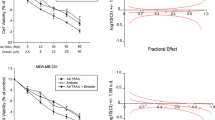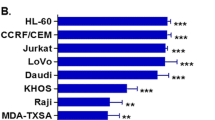Abstract
Doxorubicin is one of the most effective molecules used in the treatment of various tumors. Contradictory reports often open windows to understand the doxorubicin-mediated signaling to exert its apoptosis effect. In this report, we provide evidences that doxorubicin induced biphasic induction of nuclear factor kappaB (NF-κB) of immediate activation followed by decrease in the amount of RelA (p65) subunit possibly by inducing the activity of proteasome, but not proteases. Further induction of NF-κB was observed through interleukin 8 (IL-8), expressed by doxorubicin treatment. Increased amount of IL-8 induced apoptosis via increase in the releases of intracellular Ca2+, activation of calcineurin, nuclear translocation of nuclear factor activated T cell (NF-AT), and NF-AT-dependent FasL expression. Anti-IL-8 or -FasL antibody, dominant negative TRAF6 (TRAF6-DN), or TRAF6 binding peptide (TRAF6-BP) inhibited doxorubicin-mediated late phase induction of NF-κB and diminished cell death. Thus, our study clearly demonstrated that doxorubicin-mediated cell death is obtained through expression of IL-8. IL-8-mediated calcification is required for enhancement of doxorubicin-mediated cell death. Overall, this study will help to understand the much studied chemotherapeutic drug, doxorubicin-mediated cell signaling cascade to exert its effect during chemotherapy.






Similar content being viewed by others
References
Blum RH, Carter SK (1974) Adriamycin. A new anticancer drug with significant clinical activity. Ann Intern Med 80:249–259
Harris GR, Morrow M, Bonnadona G (1993) Cancer of the breast. Lippincott, Philadelphia, Pennsylvania 126:4–1332
Ecuyer T, Sanjeev S, Thomas R, Novak R, Das L, Campbell W, Heide RV (2006) DNA damage is an early event in doxorubicin-induced cardiac myocyte death. Am J Physiol Heart Circ Physiol 291:H1273–H1280
Yeh YC, Lai HC, Ting CT, Lee WL, Wang LC, Wang KY, Lai HC, Liu TJ (2007) Protection by doxycycline against doxorubicin-induced oxidative stress and apoptosis in mouse testes. Biochem Pharmacol 74:969–980
Eom YW, Kim MA, Park SS, Goo MJ, Kwon HJ, Sohn S, Kim WH, Yoon G, Choi KS (2005) Two distinct modes of cell death induced by doxorubicin: apoptosis and cell death through mitotic catastrophe accompanied by senescence-like phenotype. Oncogene 24:4765–4777
Barre B, Perkins ND (2007) A cell cycle regulatory network controlling NF-κB subunit activity and function. EMBO J 26:4841–4855
Sreenivasan Y, Sarkar A, Manna SK (2003) Mechanism of cytosine arabinoside mediated apoptosis: role of Rel A (p65) dephosphorylation. Oncogene 22:4356–4369
Manna SK, Aggarwal BB (1999) Lipopolysaccharide inhibits TNF-induced apoptosis: role of nuclear factor-κB activation and reactive oxygen intermediates. J Immunol 162:1510–1518
Chuang SE, Yeh PY, Lu YS, Lai GM, Liao CM, Gao M, Cheng AL (2002) Basal levels and patterns of anticancer drug-induced activation of nuclear factor-kappa B, and its attenuation by tamoxifen dexamathasone and curcumin in carcinoma cells. Biochem Pharmacol 63:1709–1716
Manna SK, Manna P, Sarkar A (2007) Inhibition of RelA phosphorylation sensitizes chemotherapeutic agents-mediated apoptosis in constitutive NF-kappaB-expressing and chemoresistant cells. Cell Death & Differen 14:158–170
Clarke DL, Sutcliffe A, Deacon K, Bradbury D, Corbett L, Knox AJ (2008) PKCbetaII augments NF-kappaB-dependent transcription at the CCL11 promoter via p300/CBP-associated factor recruitment and histone H4 acetylation. J Immunol 181:3503–3514
Manna SK, Ramesh GT (2005) Interleukin-8 induces nuclear transcription factor-κB through TRAF6-dependent pathway. J Biol Chem 280:7010–7021
Ye H, Arron JR, Lamothek B, Cirilli M, Kobayashi T, Shevdeq NK, Segal D, Dzivenu OK, Vologodskaia M, Yim M, Duk K, Singh S, Pikeq JW, Darnay BG, Choi Y, Wu H (2002) Distinct molecular mechanism for initiating TRAF6 signalling. Nature 418:443–447
Coux O, Tanaka K, Goldberg AL (1996) Structure and functions of the 20S and 26S proteasomes. Annu Rev Biochem 65:801–847
Ryo A, Suizu F, Yoshida Y, Perrem K, Liou YC, Wulf G, Rottapel R, Yamaoka S, Lu KP (2003) Regulation of NF-kappaB signaling by Pin1-dependent prolyl isomerization and ubiquitin-mediated proteolysis of p65/RelA. Mol Cell 12:413–426
Klee CB, Ren H, Wang X (1998) Regulation of the calmodulin-stimulated protein phosphatase, calcineurin. J Biol Chem 273:13367–13370
Rusnak F, Mertz P (2000) Calcineurin: form and function. Physiol Rev 80:1483–1521
Kingsbury TJ, Cunningham KW (2000) A conserved family of calcineurin regulators. Genes Dev 14:1595–1604
Abbasi S, Su B, Kellems RE, Yang J, Xia Y (2005) The essential role of MEKK3 signaling in angiotensin II-induced calcineurin/nuclear factor of activated T-cells activation. J Biol Chem 280:36737–36746
Liu S, Liu P, Borras A, Chatila T, Speck SH (1997) Cyclosporin A-sensitive induction of the Epstein-Barr virus lytic switch is mediated via a novel pathway involving a MEF2 family member. EMBO J 16:143–153
Srivastava RK, Sasaki CY, Hardwick JM, Longo DL (1999) Bcl-2-mediated drug resistance: inhibition of apoptosis by blocking nuclear factor of activated T lymphocytes (NFAT)-induced Fas ligand transcription. J Exp Med 190:253–265
Molkentin JD, Lu JR, Antos CL, Markham B, Richardson J, Robbins J, Grant SR, Olson EN (1998) A calcineurin-dependent transcriptional pathway for cardiac hypertrophy. Cell 93:215–228
Raghavendra PB, Sreenivasan Y, Ramesh GT, Manna SK (2007) Cardiac glycoside induces cell death via FasL by activating calcineurin and NF-AT, but apoptosis initially proceeds through activation of caspases. Apoptosis 12:307–318
Zhu J, Shibasaki F, Price R, Guillemot JC, Yano T, Dotsch V, Wagner G, Ferrara P, McKeon F (1998) Intramolecular masking of nuclear import signal on NF-AT4 by casein kinase I and MEKK. Cell 93:851–861
Crabtree GR, Olson EN (2002) NFAT signaling: choreographing the social lives of cells. Cell Suppl 109:S67–S79
Manna SK, Gangadharan C (2009) Decrease in RelA phosphorylation by inhibiting protein kinase A induces cell death in NF-kappaB-expressing and drug-resistant tumor cells. Mol Immunol 46:1340–1350
Gangadharan C, Thoh M, Manna SK (2009) Inhibition of constitutive activity of nuclear transcription factor kappaB sensitizes Doxorubicin-resistant cells to apoptosis. J Cell Biochem 107:203–213
Manna SK, Zhang HJ, Yan T, Oberley LW, Aggarwal BB (1998) Overexpression of Mn-superoxide dismutase suppresses TNF induced apoptosis and activation of nuclear transcription factor-B and activated protein-1. J Biol Chem 273:13245–13254
Bose JS, Gangan V, Jain SK, Manna SK (2009) Novel caffeic acid ester derivative induces apoptosis by expressing FasL and downregulating NF-KappaB: potentiation of cell death mediated by chemotherapeutic agents. J Cell Physiol 218:653–662
Sarkar A, Sreenivasan Y, Ramesh GT, Manna SK (2004) Beta-D-glucoside suppresses TNF-induced activation of nuclear transcription factor kappaB but potentiates apoptosis. J Biol Chem 279:33768–33781
Ostrakhovitch EA, Cherian MG (2005) Role of p53 and reactive oxygen species in apoptotic response to copper and zinc in epithelial breast cancer cells. Apoptosis 10:111–121
Anddrassy M, Bierhaus A, Hong M, Sis J, Schiekofer S, Humpert P, Chen J, Haap M, Renn W, Schleicher E, Haring HU, Andrassy K, Nawroth PP (2002) Erythropoietin-mediated decrease of the redox-sensitive transcription factor NF-κB is inversely correlated with the hemoglobin level. Clin Nephrol 58:179–189
Shimokawa I (2004) Oxidative stress and calorie restriction. Geriatrics & Gerontol Int 4:S149–S151
Fischer UM, Antonyan A, Bloch W, Mehlhorn U (2006) Impact of antioxidative treatment on nuclear factor kappa-B regulation during myocardial ischemia-reperfusion. Interact Cardiovasc Thorac Surg 5:531–535
Kotamraju S, Chitambar CR, Kalivendi SV, Joseph J, Kalyanaraman B (2002) Transferrin receptor-dependent iron uptake is responsible for doxorubicin-mediated apoptosis in endothelial cells -role of oxidant-induced iron signaling in apoptosis. J Biol Chem 277:17179–17187
Ujhazy P, Zaleskis G, Mihich E, Ehrke MJ, Berleth ES (2003) Doxorubicin induces specific immune functions and cytokine expression in peritoneal cells. Cancer Immunol Immunother 52:463–472
Levina V, Su Y, Nolen B, Liu X, Gordin Y, Lee M, Lokshin A, Gorelik E (2008) Chemotherapeutic drugs and human tumor cells cytokine network. Int J Cancer 123:2031–2040
Niu J, Azfer A, Wang K, Wang X, Kolattukudy PE (2009) Cardiac-targeted expression of soluble fas attenuates doxorubicin-induced cardiotoxicity in mice. J Pharmacol Exp Ther 328:740–748
Acknowledgments
This work was supported by the core grant of Centre for DNA Fingerprinting and Diagnostics (CDFD). We acknowledge the Department of Science and Technology (DST) for providing SEARC Fast Track proposal for Young Scientists grant to SKM and Council for Scientific & Industrial Research (CSIR), New Delhi for providing fellowship to CG and MT. We thank Drs. T. Ramasarma and A. K. Khar for critically and carefully reading the manuscript.
Author information
Authors and Affiliations
Corresponding author
Additional information
This article has been retracted at the request of the Centre for DNA Fingerprinting and Diagnostics as it contains manipulated figures.
The retraction note to this article can be found online at http://dx.doi.org/10.1007/s10549-013-2482-5.
An erratum to this article can be found online at http://dx.doi.org/10.1007/s10549-012-2293-0.
About this article
Cite this article
Gangadharan, C., Thoh, M. & Manna, S.K. RETRACTED ARTICLE: Late phase activation of nuclear transcription factor kappaB by doxorubicin is mediated by interleukin-8 and induction of apoptosis via FasL. Breast Cancer Res Treat 120, 671–683 (2010). https://doi.org/10.1007/s10549-009-0493-z
Received:
Accepted:
Published:
Issue Date:
DOI: https://doi.org/10.1007/s10549-009-0493-z




